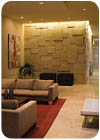
Spicing up a lobby design of a condominium complex in Austin, TX, is a two-sided wall comprised of varying-sized overlapping pieces of Texas limestone.
Architect: Dick Clark Architecture, Austin, TX
Architect: Dick Clark Architecture, Austin, TX
The scope of interior design stretches far and wide. Influences are attributed to everything from tranquil destinations such as beaches and spas to cultural traditions and regional traits. Whether designing for residential or commercial clients, architects and designers are utilizing the abundant supply of natural stone, ceramic, porcelain and glass tile product lines to develop inspiring designs.
And in many cases, it appears that subtle touches are the key to creating innovative spaces. Most homeowners desire a place where they can unwind and feel comfortable, and designs in soothing, neutral palettes are being used to achieve this goal. Mainstays such as limestone, travertine and muted shades of porcelain are being used as a canvas in kitchens, living rooms and master baths. Texture and color are added with accent pieces such as shimmering glass mosaics, rough-sawn finishes and vibrant exotic stone countertops and vanities.
In the commercial sector, interior designs often mimic residential settings. The objective is to create a relaxed atmosphere for patrons; one which is reminiscent of their homes. Public places such as store showrooms, restaurants and hotels are featuring warm color schemes with rich textures that bring dimension to a space. The expansive selection of stone and tile collections available today allow architects and designers to mix and match colors and finishes to achieve the desired effect. And sometimes, just utilizing varying tile sizes or using the same material with different finishes can enhance and add vibrancy to a design.
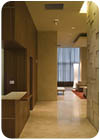
Slightly contrasting the limestone wall are 36- x 36-inch polished floor tiles, which are made from a different limestone.
A Limestone Palette
Architect Dick Clark of Dick Clark Architecture in Austin, TX, recently utilized an innovative limestone design for a condominium complex lobby in Austin, TX. He created a two-sided wall of overlapping tiles that stirs interest and serves as the focal point of the space. The varying sizes of rectangular and square tiles, which jut out from the wall, bring dimension and texture to the seating area.“We designed a random pattern of 'in and out' fluctuation of the wall, and cast light down so that the shadows on the stone give a feeling of depth,†said the architect. “They are all custom tiles of varying sizes, but not varying depth. Some have a backing of more grout in the back to make them look like they are different depths. If it didn't have the light, there wouldn't be depth.â€
According to the architect, the design was intended to have a warm Texas feel that provides a relaxing space for residents and guests to socialize. “We did not want it to look like a hokey ranch, but not ultra slick either,†explained Clark. “We wanted something in between.â€
The overlapping limestone pieces, which were quarried locally in Texas and have a re-sawn texture, were meant to resemble stacked stone that is commonly seen on ranches. “It's a suede-like finish,†said Clark. “Anyone who walks in has to touch it.â€

For the newly renovated Galerie Lassen - located in the Forum Shops at Caesars Palace in Las Vegas, NV - 20- x 20-inch travertine tiles were installed in an “H†pattern on the showroom floor. Architect: Urban Architecture & Design, Las Vegas, NV; General Contractor: General Design and Construction; Stone Supplier: Arizona Tile, Tempe, AZ and Las Vegas, NV; Glass Tile Manufacturer: Sicis
It took approximately two weeks to complete the installation of the limestone wall, according to Clark. “It is the kind of thing that starts off slow and gains speed,†he said, adding that the wall was sprayed with a matte sealer.
Adding a subtle contrast to the matte limestone wall tiles are 36- x 36-inch polished limestone floor tiles. “[The limestone] is intentionally different to slightly contrast, but it is from the same family,†explained Clark. Moreover, a third limestone was used for the reception countertop. This material also minimally differs from the other stones, and is polished, but not as shiny as the floor tiles, said the architect.
In the end, the building developer was extremely pleased with the results of the lobby design. “This was not a high budget job,†said Clark. “They were able to get what they wanted. It is the very first image that people see when they walk into the building, and the only public meeting space. [The limestone wall] dresses it up.â€
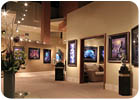
While the travertine - paired with an overall neutral color palette - created a warm inviting atmosphere in the gallery, glass tiles from the Neo Collection by Sicis were used for the base of the car platform to add a touch of Las Vegas glitz.
Reflecting the Sand and Sea
A warm color palette, including travertine and glass tile, was also used to create a plush feel in the newly renovated Galerie Lassen - located in the Forum Shops at Caesars Palace in Las Vegas, NV. The showroom's interior design is not only inviting to its customers, but also forms an elegant backdrop for the artwork of artist Christian Riese Lassen.The architectural and interior design for the remodeled gallery was directed by Joyce Orias, AIA, of Urban Architecture & Design, while the construction services were provided by Erick Sanchez of General Design and Construction. Orias explained that the gallery had previously been occupied by a Discovery Channel store.
“It was a temporary-looking space,†said the architect, explaining that the gallery had been at the new location for a couple of years, and the owner wanted a new image. “Mr. Lassen wanted to update it, and make it more fresh.â€
And since the subject matter of Lassen's artwork is primarily marine life and ocean scenes, the design objective was to have the space reflect this type of environment. “We wanted to make the space lighter and brighter and beach oriented,†said Orias.
Keeping that intention in mind, the design team elected to use travertine - supplied by Arizona Tile, which is based in Tempe, AZ, and has a Las Vegas location - for portions of the gallery's design. “We did look at some limestone, but the travertine has a quality that works here in Nevada,†said Orias. “It was the right tone and worked out the best.â€
For the main floor space, 20- x 20-inch travertine tiles were laid in an “H†pattern. Additionally, the same tiles were used on the floor of the car platform that displays a hand-painted Lamborghini with blue dolphins and blue flames. Finishing off the look, travertine pieces with a 45-degree beveled edge were used as a 9-inch base around the floor space.
“It really made the space look a lot more upscale, and also gave it a residential feel,†said Orias, adding that a large amount of the artwork purchased at the gallery is put in high-end homes.
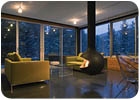
For a ski house in Winter Park, CO, 18- x 18-inch polished porcelain tiles were used to cover the flooring on the main level. Architect: Michael P. Johnson Design Studio Ltd., Cave Creek, AZ; Tile Manufacturer: Refin, Italy
The travertine pieces arrived on site unfilled, and were filled and sealed during the installation process. “We picked the stone and submitted it to Mr. Lassen for final approval,†said Orias. “We told them that it would need to be sealed annually. They understood the maintenance concerns.â€
Further contributing to the overall look and feel of the gallery's design are glass tiles from the Neo Collection by Sicis, which line the base of the car platform. “They had a hip, contemporary look,†said the architect. “[Also], they have an opalescent look that reminded us of the look of seashells.†According to Orias, the glass tile subtly ties in with the beach theme.
In total, the renovation of Galerie Lassen took approximately two months to complete. “We heard about the project in May, and the opening date was set for July 1,†said the architect, explaining that this period is an especially busy time for tourists in Las Vegas, so it was essential for the job to move quickly. “The shop had to be closed down for a couple of weeks, which was tough for revenue, but the contractor worked fast.â€
During the renovation period, Christian Riese Lassen was traveling abroad, so e-mail and conference calls were relied upon for communication. “The different time zones was really the only obstacle,†said Orias. “We were able to communicate fine.â€
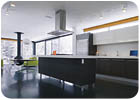
The homeowner, who also owns a loft in Manhattan, first discovered Refin tile in a magazine, and knew it would meet her design expectations.
A Winter Retreat
Aesthetics as well as practicality were the reasons for employing Italian ceramic tile on the main level of a ski house in Winter Park, CO. While the polished sheen of the gray 18- x 18-inch tiles provides attractive flooring, its durability is ideal for areas where skiers walk with boots and equipment.“The whole lower level is tile,†said architect Michael P. Johnson of Michael P. Johnson Design Studio Ltd. in Cave Creek, AZ. “Really, the strong reason for using tile is that when people come in with ski boots, they can't harm it. We chose wood for the upper level because when the owner comes back from skiing, she wants a warm surface.â€
According to Johnson, the owner of the 24,000-square-foot residence is a single woman who also owns a loft in Manhattan and is currently in the process of reconstructing another house in Boulder, CO. “The homeowner found the tile,†he said, adding that the tile was manufactured by Refin. “It's an interesting story. I had already determined that it was going to be tile [on the lower level], and she found the tile in a little write-up in a magazine. I remember her showing me, and I wasn't familiar with Refin. So, when I attended Coverings, I stopped by their booth and checked out the tile. It's beautifully made, and the colors are spectacular.â€
And the physical appearance and quality of the tile fit in with the contemporary flair of the ski house. Johnson even specified a rectified tile to minimize joints in the flooring, which flows from the living and kitchen areas to two master suites. A radiant heating system was installed underneath the tile floor for added warmth and comfort.
The installation of the tile floor was rapid, according to the architect. “When they started the tile work, the homeowner sent me some images showing the start of the installation,†he said. “By the time I got there the next week, it was finished.â€
Johnson did cite one small glitch with the installation, although in the end, it all worked out. “The tile subcontractor was very good, but he had never worked with rectified tile before,†said the architect. “There ended up being small joints, but not small enough. It was beautifully laid though, so it was okay. Even though the rectified tiles do have joints, these could be lined up at the corners.â€
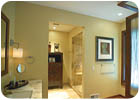
A stone palette of onyx and travertine created a Zen-like spa in the master bath of a private residence in Excelsior, MN. Architect: Vujovich, Inc., Minneapolis, MN; Designer: Eminent Interior Design, Golden Valley, MN
Asian Influences
A combination of onyx and travertine transformed a contemporary master bath into a Zen-like spa in a private residence in Excelsior, MN. The stone palette - combined with 3-inch plank Brazilian Walnut flooring - created a haven where the homeowners can retreat at the end of a tiresome day.The use of stone was essential to the remodel design, as it provided texture and depth. “I always like to start with the stones,†said designer Brandi Hagen, ASID, of Eminent Interior Design of Golden Valley, MN, who collaborated on the project with architect Taunya Nelson, AIA, ASID, of Vujovich, Inc. of Minneapolis, MN, a residential design/build firm. “You can always choose the paint colors later, and there are always fabrics and custom vanities. You need to start with the stone so that you are not so limited.â€
According to Hagen, the first material she discovered was a Pistachio onyx slab, which was employed for the vanity tops with an eased edge. “I fell in love with it,†she said, adding that the stone was also used in 6- x 6-inch tiles for a strip around the shower. “It just made sense. It's gorgeous.â€
The designer explained that the color of the onyx is what first caught her eye. “I felt like the onyx really pulled off the Asian look,†said Hagen. “I really wanted all the attention to go there, and keep the other stones more simple.â€

In the shower, travertine tiles were employed for the walls and ceiling as well as a bench. The neutral background was punctuated by a band of 6- x 6-inch onyx tiles and a mosaic floor, also made of travertine.
The travertine was filled and cut into 12- x 12-inch floor tiles. In the shower, the floor and the interior of a built-in shelf consist of 1- x 1-inch travertine mosaic tiles.
From start to finish, the remodeling project took about five months to complete, according to Hagen. In June 2006, the American Institute of Building Design (AIBD) presented Vujovich, Inc. with the prestigious “Chrysalis Award for Remodeling Excellence: Best Bath Remodel Over $50,000†to honor the firm for its work on the project.